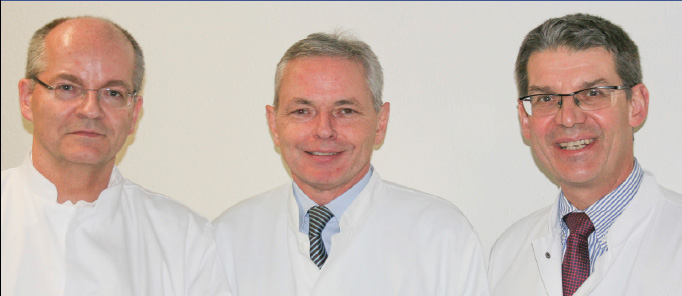Founder of the Interdisciplinary Competence Centre for Liver Diseases : Professor Vogl, Professor Zeuzem, Professor Bechstein (v.l.n.r)
Frankfurt Liver Centre
For the first time in Germany an "Interdisciplinary Competence Centre for Liver Diseases" was established in March 2007 at the University Hospital Frankfurt.

With the constellation of three specialists of high reputation - transplantation surgeon Professor Wolf-Otto Bechstein (Director and Head of Dept., Department of General and Vascular Surgery), interventional radiologist Professor Thomas Vogl (Director and Head of Dept., Institute for Diagnostic and Interventional Radiology) and gastroenterologist and hepatologist Professor Stefan Zeuzem - the centre has become a primary treatment centre for liver diseases in Germany.
Diagnosis of Liver Diseases
The symptoms of a chronic inflammatory liver disease are non-specific and can be grouped into different illnesses and syndromes by physicians.
The Process:
The patient is first examined by an internist (physician) for type and duration of the symptoms and previous known illnesses.
This is followed by detailed blood examination for differential diagnosis, which in cases of abnormalities of certain values could suggest an inflammatory liver disease. On suspicion further detailed diagnostic examinations are performed.
The internist (or radiologist) performs an ultrasound examination of the abdominal organs like the liver, pancreas, kidney and the spleen. Should the ultrasound examination reveal abnormality of the liver, further diagnostic examinations are required to confirm the diagnosis and to know the stage of the liver disease, like:
1. Contrast enhanced computer tomography (CAT-scan) of the abdomen
2. MRI examination of the liver for detailed evaluation of the liver tissue
3. Chest x-ray
4. When necessary, for absolute diagnosis, tissue biopsy is done
It is only after all examinations have been finished that the internist is able to suggest the right treatment for a particular patient.
Hepatology Today: In Confict Between Medical Advancement and Taboo
Infections with hepatitis virus is among the main causes of severe liver diseases. Over 1 million people in Germany suffer from a chronic infection with hepatitis C or B viruses (HCV and HBV), chronic infections can lead to life threatening liver cirrhosis and liver cell carcinoma (HCC).
A sharp increase in liver tumors in the last 3 years has been associated with HCV infection. Severe liver disease are mostly prevented with the help of modern diagnostic and treatment methods with very good healing chances. The effected patients usually present late which is attributed to uncharacteristic symptoms of liver diseases. Additionally false rumours about the cause and treatment modalities of liver disease are making the rounds these days. A survery conducted by "Deutsche Leberhilfe e.V" (Hep-Net-Study) on hepatitis patients showed widespread unawareness about the modes of infection, prognosis and expectations. Moreover hepatitis is considered to be the disease of drug addicts and alcoholics. "Ignorance associated with such disease whose symptoms are mostly unspecific can be fatal for the patient despite the modern medical and pharmaceutical advances", says Professor Zeuzem.
"The spectrum of causes for liver diseases is very complex and we must take other factors such as social phenomenon and trends into consideration besides medical factors", he further adds. Social factors such as dietary habits, exposure to medication which could lead to fatty liver hepatitis, the so called non-alcoholic steatohepatitis (NASH) or to toxic damage to the liver. This also means the rise in chronic virus hepatitis in Germany and world wide.
Underestimation and Consequences of NASH and Hepatitis-C
The diagnosis of NASH and chronic hepatitis has become very often today. Patients with type 2 diabetes mellitus, adipositas (over weight), metabolic syndrome or patients reduced sensitivity to insulin are susceptible to NASH. According to the micro-census conducted in 2005, about 49 percent of the population in Hessen are over weight, well every second person can be affected.
NASH is caused by disturbance balance between production of neutral fat by the liver cells and release of this neutral fat into the blood stream. The fatty changes in the liver cells leads to inflammation of the liver tissue through a complex mechanism. This results in death of liver cells due to chronic inflammation. On the long term this leads to fibrous changes and in advanced cases lead to liver cirrhosis. "Due to increasing cases of obesity and unhealthy eating habits the incidence of NASH is going to increase in Germany, 2 to 4 percent of the population already suffer from the disease", says Professor Zeuzem.
Like any other liver disease the symptoms of hepatitis-C are also unspecific. The prognosis on delayed diagnosis is even worse. The HCV-infection which causes chronic infection of the liver and destroys the genetic make-up of the liver cells, is considered one of the main predisposing factors causing hepatocellular carcinoma (HCC) or liver cancer. In about 30 percent of patients depending on the age, hepatitis -C also leads to liver cirrhosis. The Medical School of Hannover reports that the association of hepatitis with HCC has "dramatically increased" of late, that is more than half the patients with HCC had chronic viral hepatitis. The early diagnosis of hepatitis-C therefore plays a deciding role in diagnosing liver cancers and effectively treating them.
"We offer our patients an efficiently networked medical and research centre established keeping in mind the importance of complications of liver diseases like NASH, viral hepatitis, autoimmune diseases and alcohol toxicity", explains Prof. Zeuzem. "This is especially important for prevention of chronic infection and life threatening complications of liver disease", says Prof. Zeuzem.
ALL in ONE Principle Against Liver Tumors: Combined Effort of Oncological Surgery and Interventional Radiology
Therapeutic options in the Treatment of Livertumors and Metastases
The Hepatobiliary Surgery:
- Atypical (non-anatomical) wedge-resection
- Segmental resection
- Hemihepatectomy (right or left lobe)
- Extended hemihepatectomy
- Neoadjuvant chemotherapeutic procedures
- Organ transplantation
